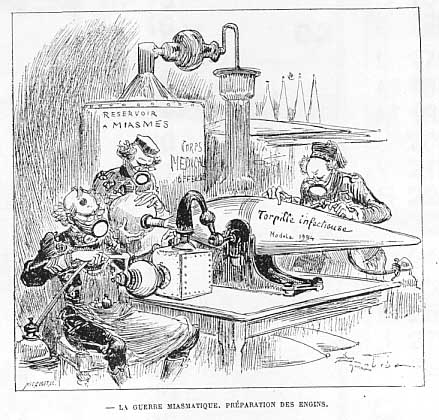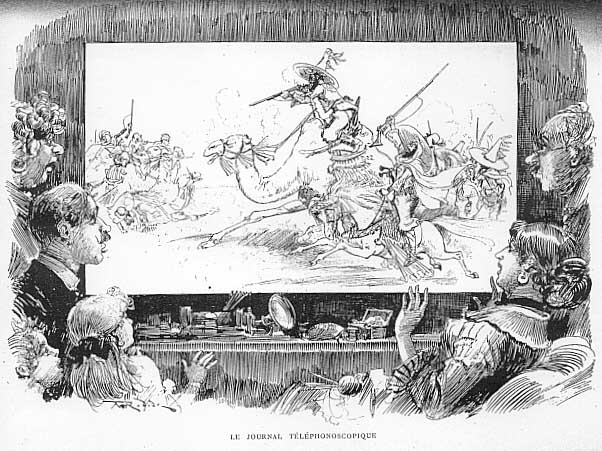|
Robida,
The Future Man! Ah, Paree… CanCan Girls, Pigale, La Belle Vie! This once great city was the hub of nations at the turn of the century before New York took over the role of planetary capitol. Today Paris is a crossroads for African and Eastern cultures. It’s changed a lot, to the point where many Frenchmen don’t recognize it anymore and are rebelling against the multiracial soup it has become by lending ever increasing support to right wing fanatics like Le Pen and his policy of hate. Except for wine, cheese and a few fashion houses still not under the tutelage of British designers, France has lost its edge as the technological wonder of the world. Gone are the days of incredible world’s fairs and mad rushes to the patent office. The French have decided to rest on their laurels, protect their language from a nebulous invasion of Americanisms, despite the fact there’s just as many French words in the English language as vice-versa! But it hasn’t always been that way. Perhaps two all consuming wars took their toll on the French spirit of innovation and exploration. Maybe the French have lost their nerve, opting instead to stand passively by as a corrupt international mafia shoves nuclear power down their throats and over charges its citizens for Internet access by a factor of ten for fear the Yankees would take over their brains! Before two bouts of insanity with the Germans, the French made miracles happen. As I walked around the Left Bank last fall I discovered a little bookstore of interest to all WEX readers. It’s called the Monte Cristo after the famed traveler. It’s on rue de l’Odeon, a street full of old and odd bookstores, a favorite hangout for students. What makes this one special is the books it sells. All leather bound and gold leaf first editions of books by Jules Verne. When you walk inside it feels like climbing on board Captain Nemo’s private study. The owner, a chain smoking intellectual by the name of Jean-Marie Embs, revels in the lore of this not so distant past when France anticipated all wonderful futures, before the rug was pulled from under those dreams. Not too intimidated by his presence, I brought up the recently rediscovered work by Jules Verne Hachette published last year, the folks who bring you ELLE, George and a multitude of car magazines. In case you don’t know the story, Jules, lets call him Jules for the sake of brevity, had submitted a first novel that his publisher promptly turned down, as publishers often do just to let you know who’s boss. Instead of reworking it until it met expectations, he buried it and wrote a brand new one, the famed “Five Weeks In A Balloon”. It wasn’t until our decade that someone dug up this first attempt again, only to discover it was all about Paris in 1960, a hundred years ahead of schedule. Jules was 35 years old when he wrote it. The year was 1863. It’s uncanny how right on the money it was and how many things he predicted correctly. Jules recycled many ideas from this first novel, “Paris In The Twentieth Century”, and by the time he was popular enough to insist on its publication, it had been the source material for so many other stories, he kept it a secret. Random House has since translated it into English. In 1984 French author Michel Lamy wrote an exhaustive study of Jules Verne’s ties with secret societies and the secret of Rennes-le-Chateau which unfortunately, to my knowledge, has yet to be translated. The French edition itself is out of print. It is called “Jules Verne, Initie et Initiateur”. My English professor at the Lycee Hoche in Versailles, a man by the name of Henrion, was the one who discovered that Shakespeare had encoded his real name, Francis Bacon, in all the original printings of his sonnets. Could such graphic magic be present in Verne’s first editions? It’s a question I put to Mr. Embs, the proprietor, but instead of answering he showed me an old book filled with curious illustrations by another author, one I’d never heard before, a contemporary of Verne: Albert Robida.
Robida has since
been experiencing a revival of sorts in France. The Canal Plus TV channel
did a special
segment on his work for French television for its Year 2000 celebration:
Not too long ago an
association calling itself The Friends of Albert Robida was formed in
France, and it is through their effort that we are now able to show you some
of these astounding drawings. Leave it to the Japanese to pick up on what
could be the patron saint of modernism, they have created a website, in
English, for those of you who would like to learn more about this
extraordinary explorer: The only institution in America, which caters to this kind of inquiry, is the Bakken Museum in Minneapolis, funded by Medtronics, the artificial heart company. The Museum has long been supervised by members of the US Psychotronics Association and is extremely open to the ideas brought forth by the readers of WEX. The Bakken is dedicated to the study of electricity in life and houses original manuscripts from the likes of Tesla, Faraday, Galvani, etc… The approach of these pioneers didn’t segregate between the divine spark and electricity as a simple motor force. Their holistic understanding of energy preceded our modern comprehension of the importance between electrical brain function and health; just as Mary Shelley’s Frankenstein did in her fictitious awakening of intelligence from a lighting strike. There’s a little booklet on my shelf published by Steven Elswick of Exotic Research, “The Letter of Petrus Peregrinus”. This letter, dated August 1269, describes how to build a compass over a hundred years before it was officially invented. Authors Lynn Picknett & Clive Prince credits Leonardo da Vinci with the invention of the bicycle in their book “The Templar Revelation”. Describing his design, which only came to light in 1960, they say: “The da Vinci roadracer had two wheels of equal size and a chain and a gear mechanism.” They also claim da Vinci created the Shroud of Turin, which would have him invent photography, nearly half a millennium before Daguerre in 1839. The point obviously, and one made very well by Peter Lemesurier in his new book “Gods Of The Dawn”, is that it’s not the invention of a scientific idea that changes human lives, but its application. Peter says on page 168: “The Greeks, in the person of Hero of Alexandria, were already successfully using a combination of steam power and jet propulsion by around the second century of our era, even if as yet only (as some believe) for opening and closing temple doors. Had not the heavy, stultifying hand of imperial Rome descended on them and choked off all further progress, Renaissance science might have taken wing a thousand years earlier than it did, the industrial revolution might have taken place by the time of Alfred the Great, and man might have been walking on the moon before the Norman conquest.” Perhaps had Robida’s work not been discounted in its day as mere flights of fancy by an overproductive imagination, and relegated to disposable cartoon art of the epoch, we’d have had TV, maybe even Web TV, and sadly biological warfare, generations before they materialized in real life. The Friends of Albert Robida can be reached by mail through Jean-Claude Viche, 25 rue François Debergue, 78170 La Celle-St-Cloud France or by email through Claude Rebeyrat at claude.rebeyrat@wanadoo.fr Their newsletter is called appropriately “Telephonoscope”. Their wonderful new website is at: http://robida.free.fr A detailed biography of Robida can be found in Philippe Brun’s book “A. Robida - Sa Vie, Son Oeuvre” available from Le Collectioneur Français, 10 rue du Pont-Louis Philippe, 75004 Paris Tel: 011-33-1-42-78-04-17 The price is around 600 Francs, or $120. Another book was published in 1980 but is out of print: “Robida Fantastique et Science Fiction” in Pierre Horay’s “Les Maitres du Dessin Satirique” series. (I’m seeking a used copy) Hopefully this article, and others like it, will convince a publishing house to reprint Robida’s titles in an affordable and accessible form. “La Vie Electrique” (The Electrical Life) is a mind blowing experience. If present science fiction is as prophetic of things to come as this book was, I’m joining the Y2K survivalists who are making the Real Goods mail order catalog company the hottest new stock on Wall Street! |

